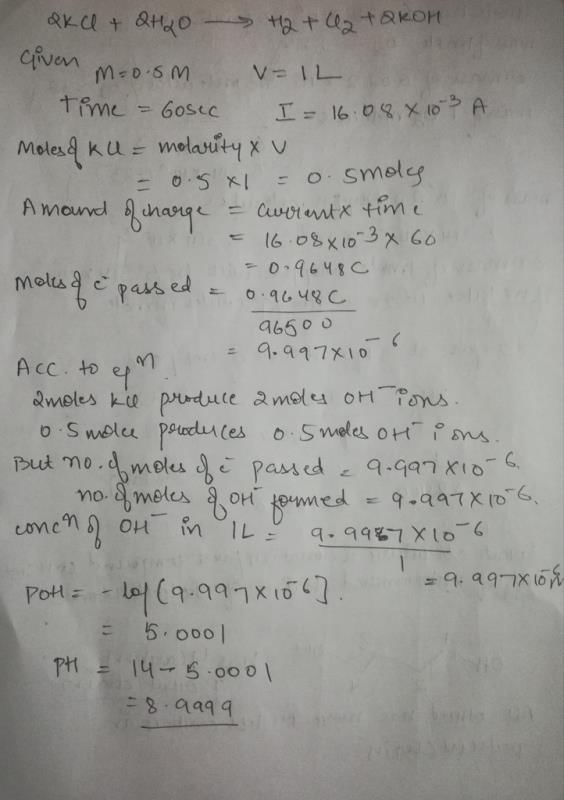Class 12 Exam > Class 12 Questions > 1 litre of 0.5M KCl solution is electrolysed ...
Start Learning for Free
1 litre of 0.5M KCl solution is electrolysed for one minute on a current of 16.08mA.Considering 100% efficiency the pH of resulting solution will be?
Most Upvoted Answer
1 litre of 0.5M KCl solution is electrolysed for one minute on a curre...

Community Answer
1 litre of 0.5M KCl solution is electrolysed for one minute on a curre...
Calculation of moles of KCl electrolysed
To calculate the pH of the resulting solution, we need to first find out the moles of KCl electrolysed.
Using the formula, Moles = Concentration x Volume, we get:
Moles of KCl = 0.5 x (1/1000) = 0.0005 moles
Calculation of charge passed
Next, we need to calculate the charge passed during electrolysis.
Using the formula, Charge = Current x Time, we get:
Charge passed = 16.08 x (1/60) = 0.268 C
Calculation of moles of H+ and OH-
During electrolysis, KCl is converted into K+ and Cl-. The water molecules are also electrolysed to form H+ and OH-.
The reactions are:
2H2O → O2 + 4H+ + 4e-
2H2O + 2e- → H2 + 2OH-
We can see that for every 2 electrons that pass through the solution, one molecule of H2O is converted into H+ and OH-.
Therefore, the total number of electrons passed through the solution can be calculated as:
Number of electrons = Charge / (Faraday constant x 1000)
Where Faraday constant = 96485 C/mol
Number of electrons = 0.268 / (96485 x 1000) = 2.77 x 10^-6 mol
Since each electron produces one H+ ion and one OH- ion, the number of moles of H+ and OH- produced can be calculated as:
Moles of H+ and OH- = Number of electrons / 2 = 1.385 x 10^-6 mol
Calculation of pH
The resulting solution will be basic since the number of moles of OH- is higher than the number of moles of H+.
The concentration of OH- can be calculated as:
[OH-] = Moles of OH- / Volume of solution
Since the volume of the solution is 1 litre, we get:
[OH-] = 1.385 x 10^-6 M
Using the formula, pOH = -log[OH-], we get:
pOH = -log(1.385 x 10^-6) = 5.86
The pH can be calculated as:
pH = 14 - pOH = 8.14
Therefore, the pH of the resulting solution will be 8.14.

|
Explore Courses for Class 12 exam
|

|
Similar Class 12 Doubts
1 litre of 0.5M KCl solution is electrolysed for one minute on a current of 16.08mA.Considering 100% efficiency the pH of resulting solution will be?
Question Description
1 litre of 0.5M KCl solution is electrolysed for one minute on a current of 16.08mA.Considering 100% efficiency the pH of resulting solution will be? for Class 12 2025 is part of Class 12 preparation. The Question and answers have been prepared according to the Class 12 exam syllabus. Information about 1 litre of 0.5M KCl solution is electrolysed for one minute on a current of 16.08mA.Considering 100% efficiency the pH of resulting solution will be? covers all topics & solutions for Class 12 2025 Exam. Find important definitions, questions, meanings, examples, exercises and tests below for 1 litre of 0.5M KCl solution is electrolysed for one minute on a current of 16.08mA.Considering 100% efficiency the pH of resulting solution will be?.
1 litre of 0.5M KCl solution is electrolysed for one minute on a current of 16.08mA.Considering 100% efficiency the pH of resulting solution will be? for Class 12 2025 is part of Class 12 preparation. The Question and answers have been prepared according to the Class 12 exam syllabus. Information about 1 litre of 0.5M KCl solution is electrolysed for one minute on a current of 16.08mA.Considering 100% efficiency the pH of resulting solution will be? covers all topics & solutions for Class 12 2025 Exam. Find important definitions, questions, meanings, examples, exercises and tests below for 1 litre of 0.5M KCl solution is electrolysed for one minute on a current of 16.08mA.Considering 100% efficiency the pH of resulting solution will be?.
Solutions for 1 litre of 0.5M KCl solution is electrolysed for one minute on a current of 16.08mA.Considering 100% efficiency the pH of resulting solution will be? in English & in Hindi are available as part of our courses for Class 12.
Download more important topics, notes, lectures and mock test series for Class 12 Exam by signing up for free.
Here you can find the meaning of 1 litre of 0.5M KCl solution is electrolysed for one minute on a current of 16.08mA.Considering 100% efficiency the pH of resulting solution will be? defined & explained in the simplest way possible. Besides giving the explanation of
1 litre of 0.5M KCl solution is electrolysed for one minute on a current of 16.08mA.Considering 100% efficiency the pH of resulting solution will be?, a detailed solution for 1 litre of 0.5M KCl solution is electrolysed for one minute on a current of 16.08mA.Considering 100% efficiency the pH of resulting solution will be? has been provided alongside types of 1 litre of 0.5M KCl solution is electrolysed for one minute on a current of 16.08mA.Considering 100% efficiency the pH of resulting solution will be? theory, EduRev gives you an
ample number of questions to practice 1 litre of 0.5M KCl solution is electrolysed for one minute on a current of 16.08mA.Considering 100% efficiency the pH of resulting solution will be? tests, examples and also practice Class 12 tests.

|
Explore Courses for Class 12 exam
|

|
Signup for Free!
Signup to see your scores go up within 7 days! Learn & Practice with 1000+ FREE Notes, Videos & Tests.





















